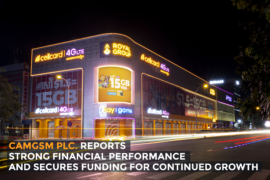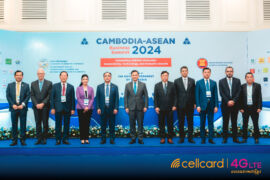
Cambodia’s telecom market has had a turbulent history, one that has seen overcrowding, consolidations, mergers, bankruptcies, price wars, and changing legislation over the years.
All these are growing pains that have hastened the development of the country’s digital landscape, putting Cambodia well on its path towards a more connected digital future.
Cambodia is a classic example of a technology leapfrog, completely skipping the landline era that served as the industry building block for most other countries. Starting from 25 years ago when landlines were few, mobile connectivity almost non-existent, and dial-up internet required no infrastructure, the rapid development of the telecommunication industry has caused the rest of the world to take notice.
According to the ITU, a United Nations agency that specializes in information and communication technologies, Cambodia had the highest ratio in the world for wireless telephone subscribers and was the first country in the world where mobile telephone subscribers overtook subscribers on fixed lines.
By 2010, the rate of mobile telecom penetration had reached 75% of the total population.
By 2016, The Asia Foundation, reported that 96% of Cambodians owned a phone, and 48% of them owned a smartphone, while 33% of them had access to the internet through their device.
In 2018, Cambodian users accounted for nearly 50% of all global traffic for Facebook Messenger’s voice function, attesting to widespread connectivity, social media adoption, and technology literacy.
In 2019, the World Bank declared Cambodia as having one of the world’s highest uses of mobile data per capita among low- and lower-middle-income countries; 6.9 gigabytes per capita per month.
In 2022, the Ministry of Posts and Telecommunications reported that Cambodia has some 17.8 million internet subscribers, exceeding the country’s total population of 16 million, of which 17.48 million have subscribed to mobile internet service and 312,233 to fixed internet service.
In 2023, Cambodia’s e-commerce market is poised to reach $1.78 billion by 2025, fueled by the rapid adoption of digital payments in the kingdom. According to Khmer Enterprise estimates, among 17.06 million people, there were 22.06 million mobile phone connections, 13.44 million internet users, and 12.6 million social media users in Cambodia.
And while Cambodia awaits the release of the Cambodian Government Policy on 5G, Cambodia’s top operators have been preparing for the dawn of industry 4.0.
Cambodia’s only locally owned operator, Cellcard, hosted the first successful trials of a standalone (SA) 5G site in 2019, reaching speeds of 1.6 Gigabits per second (Gbps). In 2020, Cellcard rolled out the first 5G use case to aid Cambodia during the COVID-19 pandemic via a telemedicine service at four locations across Phnom Penh, enabling Phnom Penh’s leading doctors to assess patients nationwide via video conference link to mobile phones and devices. In the same year, Cellcard signed a major framework agreement with ZTE for the introduction of 5G and the increase of 4G coverage and capacity across Cambodia.
Cellcard has seen through Cambodia’s entire connectivity development, with a long history of firsts that spans 25 years, including pioneering the prepaid market, which accounts for 99% of the industry today.
Currently, the brand is the only locally owned, single market operator in a market dominated by regional behemoths Axiata and Viettel.Together, these players are regarded as Cambodia’s “big three.”
Cellcard, as a local business, has been championing Khmer pride by representing the Kingdom on regional and international platforms and winning over 40 local, regional, and global awards for its network performance, products and services, innovation, and corporate initiatives. Its ability to confidently stand side by side with some of the world’s biggest industry names speaks volumes about not just the brand but also Cambodia’s potential and ability to rise and be counted as one of Asia’s sleeping giants.
It all began in 2017, with an aggressive 4G coverage rollout that saw its sites increase from 300 to 3000, forcing the world to take a second look at this local operator and propelling the brand from being the last operator to roll out 4G to Cambodia’s most awarded telecom. Included in its roster of awards are wins from global telecom performance indicators Ookla and OpenSignal for three years in a row from 2017–2019, accolades from international business magazines, and industry excellence awards, among many others.
In 2021, Cellcard started on a turnaround strategy spearheaded by its new Chief Executive Officer, Simon Perkins, a vastly experienced leadership figure in the telecommunications industry with a proven track record of successfully driving organizations across global markets and a reputation in the technology, infrastructure, and banking sectors. Under his leadership, Cellcard started on a path to regain network dominance with the vision of leading the digitization of Cambodia, and cementing Cellcard as the network of choice across key segments of the consumer, government, and corporate sectors.
After losing out on its winning streak at the world-renowned and prestigious Ookla and Opensignal Awards, Cellcard makes a strong comeback this year.
Cellcard begins 2023 strong, reclaiming its place as Cambodia’s Fastest Mobile Network with its Ookla Award Win, as the network with the Fastest Download Speeds and Excellent Consistency with its OpenSignal Award Win, and claiming a spot in the world’s Top 30 for most improved network performance and recipient of the Global Rising Star Award.
“Our customers are the lifeblood of our business. Enhancing their experience on our network has a positive impact on our bottom line, but beyond that, the initiative ensures business continuity. In 2022, Cellcard celebrated its 25th anniversary, a milestone achievement for any business, let alone for a locally owned, single-market telecom company amidst regional giants in an aggressive, saturated market. The initiative puts a renewed focus on the basics of what we do—connecting people, and at the center of that is our network. Investing in our network is akin to investing in our future, ensuring that the business continues to grow in its capability together with our customers’ needs and foreshadowing the demands of Cambodia’s digital future.” — Simon Perkins, CEO Cellcard.
Driving by Phnom Penh’s CBD along Sihanouk Blvd., one can’t help but notice the Cellcard Head Office, which, like its business, is bigger, better, and re-energized. We see Cellcard, and because it’s been a permanent part of Cambodia’s business landscape, we take it for granted. But there is much to be said about its persistent existence, its achievements, and its contributions to shaping the telecom industry of the Kingdom as we know it today.



















